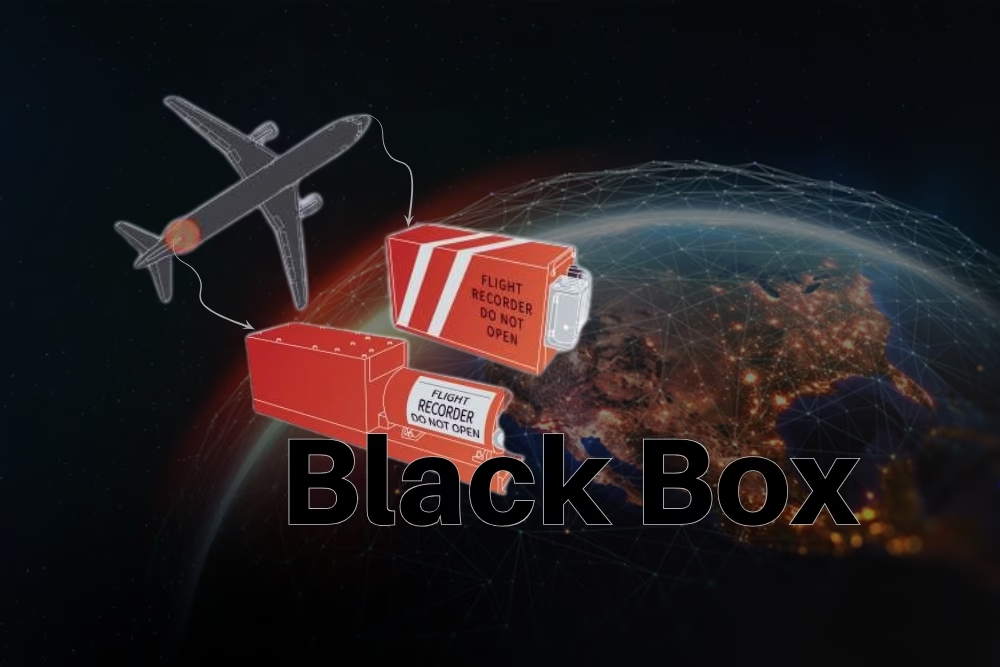When news of a plane crash breaks, one of the first things aviation experts and investigators look for is the black box. It holds the clues—sometimes the only ones—that can explain exactly what went wrong. But despite the dramatic name, a black box isn’t black at all. And it’s not just a mysterious chunk of metal hidden deep inside the aircraft. It’s a purpose-built recorder, designed to withstand unimaginable forces, fire, and ocean depths, all to tell the story of a flight’s final moments.
Let’s take a closer look at what this remarkable device really is, what it records, and why it matters so much in aviation.
More Than a Box: What Does It Actually Do?
Each commercial airplane is equipped with two types of recorders:
- Flight Data Recorder (FDR)
- Cockpit Voice Recorder (CVR)
Together, these devices collect and preserve critical information about the flight. The FDR monitors hundreds to thousands of parameters, such as altitude, speed, engine settings, autopilot commands, and much more. Meanwhile, the CVR records audio from the cockpit—including conversations between pilots, communications with air traffic control, and even the subtle background sounds like alarms, switches, and engine noise.
These recordings don’t just serve technical purposes. They capture context, human decision-making, and clues that might otherwise be lost forever.
Built to Survive What the Aircraft Couldn’t
The black box is engineered to survive conditions that no aircraft can. It’s encased in a bright orange, high-strength metal shell that’s not only waterproof but also resistant to crushing impacts, searing heat, and deep-sea pressure.
To give you an idea of its toughness:
- It can survive crash impacts of up to 3,400 Gs
- It’s tested to endure temperatures over 1,100°C for at least an hour
- It remains functional after being submerged in saltwater for 30 days
This durability ensures the recorded data remains intact, even if the rest of the aircraft has been destroyed beyond recognition.
A Glimpse into the Past: The Origins of the Black Box
The concept of a flight recorder dates back to the 1930s, when François Hussenot, a French engineer, developed one of the earliest data recorders. It used photographic film to log parameters, enclosed in a sealed, light-tight box. This was the original ‘black box’—the name likely stuck due to its concealed nature, even though the color was never black. In fact, the bright international orange we see today was chosen from the start to make the device easier to locate among wreckage.
Over time, the technology moved from film to magnetic tapes, and now to solid-state memory chips, which are faster, more durable, and capable of storing massive amounts of data with no moving parts to fail.
How Much Can It Store?
Early flight recorders could handle just a few dozen data points. Fast-forward to today, and recorders on advanced aircraft like the Airbus A350 can store around 3,500 parameters for up to 25 hours. These include:
- Control inputs
- Engine performance
- Fuel system activity
- Hydraulic and electrical systems
- Flight control positions
- Cockpit displays and autopilot settings
Each new generation of aircraft brings more sophisticated systems—and the black box keeps pace by logging more data, more efficiently.
When Recovery Becomes a Challenge
In some tragic accidents, especially those involving ocean crashes, recovering the black box can be incredibly difficult. To tackle this issue, the aviation industry is turning to new technologies:
Data Streaming
Aircraft manufacturers are exploring the use of satellite data streaming, which transmits key flight information in real time. That way, if a plane goes down in deep waters, some vital data has already been sent and stored safely elsewhere.
Automatic Deployable Flight Recorders
This next-gen solution is designed to automatically eject from the aircraft during a crash. The recorder floats, transmits its location, and increases the chances of fast recovery—even in remote areas.
Combined Recorders and Longer Audio
Historically, cockpit voice recorders saved only 2 hours of audio. But that’s changing. The International Civil Aviation Organization (ICAO) now requires new recorders to store 25 hours of audio, ensuring that the entire flight is captured.
Some aircraft now use combined recorders, storing both voice and flight data in one device. On long-haul aircraft, these are often the deployable type mentioned earlier.
What About Helicopters?
It’s not just airplanes that carry black boxes. Helicopters, especially larger models, also have combined recorders. These devices track between 800 to 1,200 flight parameters, such as rotor speed, heading, altitude, and engine power. Just like their airplane counterparts, they’re designed to survive extreme temperatures and crashes.
Why the Black Box Matters So Much
When disaster strikes, emotions run high, and questions come fast. The black box doesn’t just store numbers and sounds—it holds answers. It’s a critical tool for:
- Reconstructing events during an accident
- Identifying what went wrong and why
- Improving training, aircraft design, and safety protocols
- Giving closure to families and communities
In aviation, every lesson learned from an incident can save lives in the future. And the black box is often the key to unlocking those lessons.
The black box may seem like just a technical component hidden inside the aircraft, but in reality, it’s one of the most important pieces of the aviation safety puzzle. It listens when no one else can. It remembers when everything else is lost. And it speaks for those who can no longer tell their story.
As technology continues to evolve, so does the black box—carrying the responsibility of making air travel safer with every flight.



